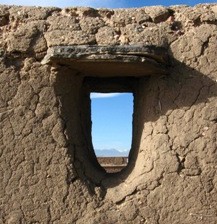Revival Styles
 Pueblo – The Pueblo Revival style draws upon local historical precedents for inspiration. Pueblo Revival Buildings contain a mixture of elements from both Native American pueblos and flat-roofed Spanish Colonial buildings. Native Americans led a stable agricultural lifestyle in the Southwest.
Pueblo – The Pueblo Revival style draws upon local historical precedents for inspiration. Pueblo Revival Buildings contain a mixture of elements from both Native American pueblos and flat-roofed Spanish Colonial buildings. Native Americans led a stable agricultural lifestyle in the Southwest.
Spanish – The Spanish Colonial Revival style draws upon the Spanish Franciscan missions in California and the Southwest for inspiration. Beginning in the 1880s, Anglo Americans started to identify California’s Spanish heritage as an appropriate cultural expression for their burgeoning real estate developments.
Colonial – The Spanish Colonial Revival style draws upon the Spanish Franciscan missions in California and the Southwest for inspiration. Beginning in the 1880s, Anglo Americans started to identify California’s Spanish heritage as an appropriate cultural expression for their burgeoning real estate developments.
Rustic Style – Rustic Style architecture was intended to provide simple pragmatic solutions, following both function and nature. The style evolved around the turn of the twentieth century from a new romanticism about nature and the American frontier. Perhaps for the first time in the history of American architecture, a building became an accessory to nature.
 Modern Styles
Modern Styles
Art Deco – The term “Art Deco” comes from the Exposition Internationale des Arts Decoratifs et Industriels Modernes, held in Paris in 1925. Guidelines for this exposition of decorative arts called for original entries with modern inspiration; “reproductions, imitations and counterfeits of ancient styles” were prohibited.
Art Moderne – Art Moderne, also referred to as Moderne or Streamline Moderne, followed the Art Deco style in its rejection of traditional ornamentation. Popular throughout the 1930s, Art Moderne looked to the modern machine age for inspiration, especially the beginning of streamlined industrial design for ships, airplanes, and automobiles.
Modernist – Modernist designs reflect an attempt to keep building forms simple and resist traditional ornamentation. While Art Moderne architecture was modeled after the rounded streamlined forms of industrial design for ships and other modes of transportation, Modernist architecture utilized a geometric rationality.



